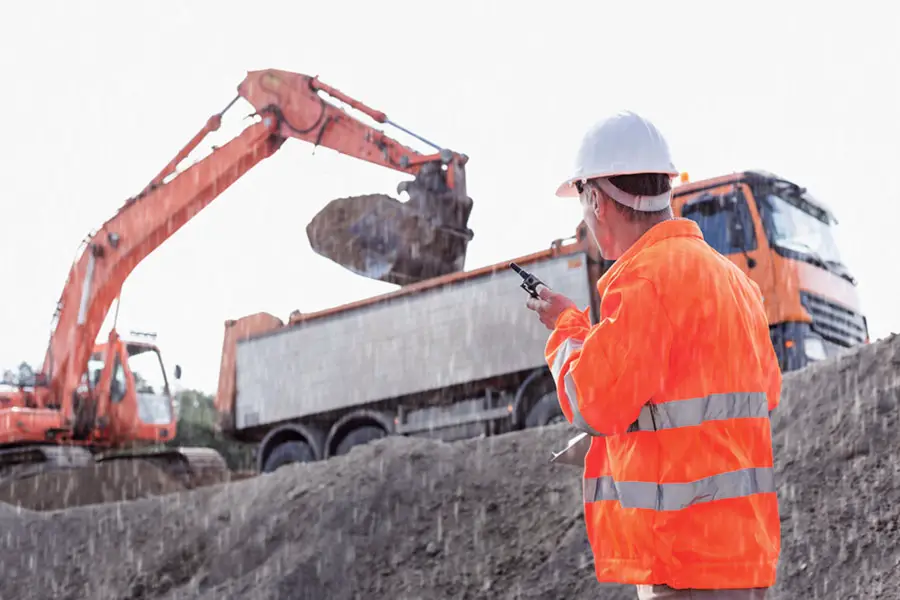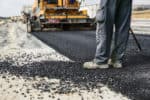Rain is not a very pleasant condition to work in.
While light rain can be tackled with certain precautions if the work in hand demands immediate completion, heavy rain on the other hand can prove too troublesome and hazardous to work in especially for construction works like bricklaying, roofing, earthing, etc.
Not only rain poses dangers of slipping in the mud, washing off of the wet concrete, heavy rain with thunder can prove to be fatal to work in the open. Also, activities like welding or any other electrical connection setup should be avoided in the rain.
Though OSHA does not set any specific standards for working in the rain, yet it states that during heavy rain, construction works like loading and unloading objects with cranes and hoists should be avoided and any electrical activity should not be carried through in rain as they pose dangers of electrocution.

Down this article let’s learn more about construction works in the rain, how much harmful can rain prove to the construction workers and what all measures can be taken to avoid damage by rain and also the dos and don’ts of construction work in rain…
So, let’s get started…
How the construction work is affected in rain?
Heavy rain accompanied with thunderstorm, hailstorm, high velocity wind, etc can affect the construction work in a number of ways:
1.) The slippery and muddy construction site can cause the vehicles to skid and cause accidents, so loading and unloading through vehicles are not allowed in the rain
2.) Bricklaying and concrete pouring are not allowed in the rain as heavy rain can wash off the top layer of the cement and cause severe damage to the construction site
3.) No electrical work is permitted in the rain as it poses the danger of electrocution. So, activities such as welding, operation of any machine, operation of any vehicles such as cranes, etc. are not allowed
4.) In case of severe weather conditions, all the construction works get cancelled and remain closed until further notifications are generated by the site owner and the engineers
5.) Works such as roofing and cementing of the outer walls of the building are also restricted in the rain
What construction activities can be performed in the rain?
In case of light rain, the following construction activities can be carried on without any danger:
Any indoor activities after the building is being made
Outdoor activities such as stone grinding, cement mixing (in case of light rain), surveying, etc. can be done in the rain
Risks involved while carrying on construction work in the rain
Not only the construction work is affected in the rain, but there are certain risks that are posed on the construction workers due to rain which are as follows:
1.) The rain can make the mud slippery which can prove dangerous for the workers as it will pose slipping hazards especially while carrying loads
2.) If machines such as cranes and derricks operate in the rain, the machine can get electrocuted in the presence of a thunderstorm and can cause electrical hazards for the workers
3.) Similarly, activities such as welding if done in the open while a thunderstorm, can also pose electrical hazards for the workers
4.) If the rain is accompanied by wind, carrying heavy loads in such situations in the construction site can prove to be fatal
5.) Above all, if the walls of the building are freshly laid, heavy rain and wind can cause the building to fall off entirely causing massive hazard to the site as well as to the workers
OSHA guidelines for working in the rain
As I have already mentioned in the introduction of this article, OSHA does not set any particular rules or guidelines for working in the rain.
But it does definitely have some set guidelines for major works in the open grounds like the construction, welding and logging:
1.) There should be limitation to the use of vehicles like cranes, hoists and derricks for carrying load in the construction site during heavy rain
2.) Activities such as operation of the crane in rain accompanied by thunderstorm can prove fatal as the crane rod can be electrically charged in the thunderstorm
3.) In case of windy rain, carrying heavy loads in the sites should be avoided as the wind can change the direction of the moving load and pose accidental threats to the surrounding workers
4.) OSHA also states that until and unless employers cannot provide adequate protection to the workers in rainy conditions, no work should be performed in the site unless conditions become fair or threat free
5.) OSHA sates that employers should be adequately protected against cold stress such as frostbite, trench foot and hypothermia by providing them with the right protective clothing against wind and rain
6.) For rescue and clean-up works, OSHA states that emergency workers must be sent to the site in case of thunderstorms and hurricanes that cause damages like flooding of the site, release of chemicals that might come in contact with the workers, electrocution of downed power lines
Will workers be paid/ is an employer required to pay an employee who does not report to work due to bad weather?
Whether an employer has to pay an employee for not working in the rain depends on 3 factors:
1.) If the weather is not that bad and work in the site continues:
Sometimes it so happens that workers misuse the opportunity and take leave for the day for personal causes while the weather condition is not that bad to continue work in the construction site.
In such cases, it entirely depends on the employer to judge the situation and to pay or cancel his payment for the day.
2.) If the employer declares leave for the day due to bad weather:
In case of severe rain such as rain accompanied with thunderstorm or hailstorm, the employer may declare the day as a leave or call off the day in between work due to unforeseen sudden circumstances.
In such cases, the employer is definitely required to pay in full to all its employees.
3.) If it is an alarming situation and has been forecasted in the news already:
If the weather has not been favourable for a long period of time and it has been already announced in the news of some dangerous weather conditions, the employer needs to close the work in the construction for a certain period of time until the weather becomes fine and has to pay all his workers for that period of time.
And it’s a wrap!
So, in conclusion, we can tell that working in rain in the construction site will depend on the intensity of rain. If it’s just a drizzle or light rain for a short period of time, work can very well continue in the site.
But if the rain is heavy and accompanied by thunderstorm or flood, all construction sites need to be closed until favourable conditions sets back.
That’s all folks for this post. I hope you enjoyed reading this article and if so, do stay tuned for more such exciting articles on all fields of profession and their work wears!
Till then…
Take care, keep smiling, keep working and have a great day ahead!







